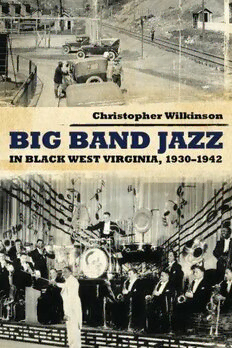
Big Band Jazz in Black West Virginia, 1930-1942 PDF
Preview Big Band Jazz in Black West Virginia, 1930-1942
Big Band Jazz in Black West Virginia, 1930–1942 This page intentionally left blank Big Band Jazz in Black West Virginia, 1930–1942 (cid:8) (cid:8) (cid:8) Christopher Wilkinson University Press of Mississippi / Jackson American Made Music Series Advisory Board David Evans, General Editor John Edward Hasse Barry Jean Ancelet Kip Lornell Edward A. Berlin Bill Malone Joyce J. Bolden Eddie S. Meadows Rob Bowman Manuel H. Peña Susan C. Cook David Sanjek Curtis Ellison Wayne D. Shirley William Ferris Robert Walser www.upress.state.ms.us The University Press of Mississippi is a member of the Association of American University Presses. Copyright © 2012 by University Press of Mississippi All rights reserved Manufactured in the United States of America First printing 2012 ∞ Library of Congress Cataloging-in-Publication Data Wilkinson, Christopher, 1946– Big band jazz in black West Virginia, 1930-1942 / Christopher Wilkinson. p. cm. — (American made music series) Includes bibliographical references and index. isbn 978-1-61703-168-7 (cloth) — isbn 978-1-61703-169-4 (ebook) 1. Jazz—West Virginia—1931–1940—History and criticism. 2. African American coal miners—West Virginia— Social life and customs—20th century. I. Title. ML3508.7.W5W55 2012 781.65089’960730754—dc23 2011020889 British Library Cataloging-in-Publication Data available To Carroll Wetzel Wilkinson, Samuel Wilkinson, Bobbi Nesbitt, Alexis Wilkinson, Jack Wilkinson, and especially to the memory of my mother, Jule Porter Wilkinson Their patience and support made this book possible. This page intentionally left blank Contents ix Preface 3 Introduction: Coal, Railroads, and the Establishment of African American Life in West Virginia part one The Economic Foundation of Big Band Dance Music in the Mountain State 35 chapter one From the Coal Face to the Dance Floor: Black Miners as Patrons of Big Bands 48 chapter two Validating Herbert Hall’s Contention: Paul Barnes’s Gig Book part two Big Bands in Black West Virginia: 1929–1935 61 chapter three Newspapers and Radio Bring the World of the Big Bands to Black West Virginia 68 chapter four Local and Territory Bands in the Emerging Culture of Big Band Jazz and Dance Music in the Mountain State 86 chapter five Big Band Jazz Comes to the Mountain State: 1929–1933 102 chapter six Comparative Prosperity Arrives, September 1933–April 1935 viii Contents part three West Virginia in the Swing Era, 1935–1942 125 chapter seven The Place of the Mountain State on the Road Traveled by the Big Bands 140 chapter eight The Big Bands’ Audience in the Mountain State 148 chapter nine The Dance Repertory Played in the Coal Fields 165 chapter ten The Party Winds Down 179 Notes 185 Works Cited 191 Index Preface Mention the state of West Virginia to many devotees of American music, and they would probably envision small ensembles of white musicians playing fiddles, guitars, banjos, and upright (that is, string) basses. Occa- sionally, a hammer dulcimer might be part of the sonic mix of such string bands, but no keyboards, rarely drums. Depending on a group’s preferred style or that of a particular piece, the music might be labeled old timey or traditional, bluegrass or country. The repertory could range from fiddle tunes of long ancestry and gospel hymns of the early twentieth century to songs by bluegrass masters, who began to define this style after World War II and brought it to prominence by the end of the 1950s, and more recent music by the singer/songwriters who call Nashville, Tennessee, home. Such perceptions of this musical culture are overly simple. Most obvi- ously, current technology has made an enormous variety of musical styles accessible to West Virginians, who may choose to engage with almost any musical tradition found in the world. Less obvious may be the fact that, despite what may seem at present to be a kind of stylistic and racial homo- geneity within the musical culture native to the Mountain State, its musi- cal past was more complicated. The place of big band jazz in West Virginia during the 1930s and early 1940s has not been studied until now, nor, for that matter, has West Virgin- ia’s place in the history of big band jazz of that time. These intertwined per- spectives reveal a great deal not previously known about how this music was imported to the state from the major northern cities that were home to the leading bands of the period. While one encounters passing descrip- tions of the tours dance bands made during the Swing Era, until now those tours have not been closely examined from the perspective of the audience to be found along the routes the bands followed. Who were they? In a time of economic crisis, how did they acquire the financial resources to attend dances with great regularity? Where did the dances take place? Who orga- nized them? How did word get out that a band was going to be performing in a particular location? ix
